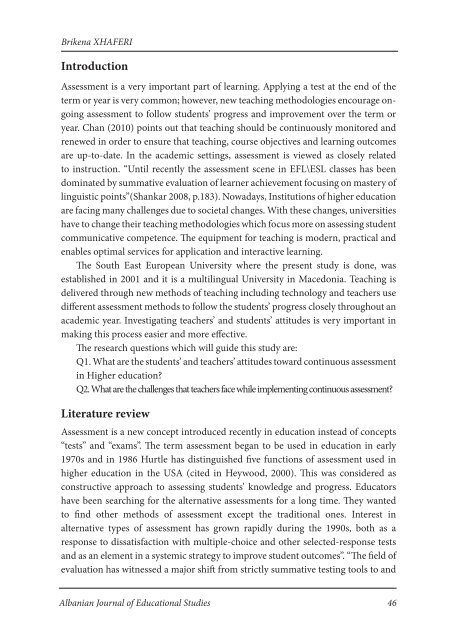Brikena XHAFERIIntroductionAssessment is a very important part of learning. Applying a test at the end of theterm or year is very common; however, new teaching methodologies encourage ongoingassessment to follow students’ progress and improvement over the term oryear. Chan (2010) points out that teaching should be continuously monitored andrenewed in order to ensure that teaching, course objectives and learning outcomesare up-to-date. In the academic settings, assessment is viewed as closely relatedto instruction. “Until recently the assessment scene in EFL\ESL classes has beendominated by summative evaluation of learner achievement focusing on mastery oflinguistic points”(Shankar 2008, p.183). Nowadays, Institutions of higher educationare facing many challenges due to societal changes. With these changes, universitieshave to change their teaching methodologies which focus more on assessing studentcommunicative competence. The equipment for teaching is modern, practical andenables optimal services for application and interactive learning.The South East European University where the present study is done, wasestablished in 2001 and it is a multilingual University in Macedonia. Teaching isdelivered through new methods of teaching including technology and teachers usedifferent assessment methods to follow the students’ progress closely throughout anacademic year. Investigating teachers’ and students’ attitudes is very important inmaking this process easier and more effective.The research questions which will guide this study are:Q1. What are the students’ and teachers’ attitudes toward continuous assessmentin Higher education?Q2. What are the challenges that teachers face while implementing continuous assessment?Literature reviewAssessment is a new concept introduced recently in education instead of concepts“tests” and “exams”. The term assessment began to be used in education in early1970s and in 1986 Hurtle has distinguished five functions of assessment used inhigher education in the USA (cited in Heywood, 2000). This was considered asconstructive approach to assessing students’ knowledge and progress. Educatorshave been searching for the alternative assessments for a long time. They wantedto find other methods of assessment except the traditional ones. Interest inalternative types of assessment has grown rapidly during the 1990s, both as aresponse to dissatisfaction with multiple-choice and other selected-response testsand as an element in a systemic strategy to improve student outcomes”. “The field ofevaluation has witnessed a major shift from strictly summative testing tools to andAlbanian Journal of Educational Studies 46
Asessment in Higher Education – A study conducted at SEEUprocedures to a more humanistic approach using informal assessment techniquesthat stress formative assessment” (Shankar 2008, p. 181). Alternative assessmentsrange from written essays, <strong>per</strong>formance, portfolios of diverse work products, roleplays, interviews and conferences. Alternative assessment uses activities that revealwhat students can do with language, it is designed and structured differently fromtraditional tests, but are also graded or scored differently. “Since it will involvedata gathering over a long <strong>per</strong>iod of time, it will yield more accurate data reachingthe teachers early enough to modify instruction. This could play a vital role indiagnosing and remediating areas of learners’ weakness if pro<strong>per</strong>ly anchored inwhat occurs in classroom (Ononyumolo, ND)”.Pierce and O’Malley (cited in Shankar, 2008, p.183) state that “ assessment isany method of finding out what a student knows or can do that is intended to showgrowth and inform instruction and it is not standardized or traditional test”. Ithelps instructors emphasize that the point of language learning is communicationfor meaningful purposes (The National Capital Language Resource Center,Washington, DC, 2004). It also emphasizes learner-centered classroom because itpromotes constructivism in learning. They are based on the idea that students canevaluate their own learning and learn from the evaluation process. These methodsgive learners opportunities to reflect on both their linguistic development and theirlearning processes (The National Capital Language Resource Center, Washington,DC, 2004). As stated by Nitko (2004 cited in Mikre 2010, pg.103),” results fromclassroom learning activities, quizzes, tests, class projects, assignment pa<strong>per</strong>s,informal observations on how well the student has attained the intended learningtargets can be used to grade students for a lesson, or unit, a marking <strong>per</strong>iod, orcourse”. Nevertheless, continuous assessment has sometimes its’ difficulties assummarized by Black and William (2004) with respect to assessment for learningin higher learning institutes are the following the assessment methods thatinstructors use are not effective in promoting good learning, Grading practicestend to emphasize competition rather than <strong>per</strong>sonal improvement, and Assessmentfeedback, if at all exists often has negative impact particularly on low-achievingstudents, who are led to believe that they lack ability and so are not able to learn. (p.104)Among the alternative methods of assessing students, portfolio assessment wasfound to be very applicable. As a result teachers are using the traditional methodsof assessing students’ <strong>per</strong>formance, and not using the other methods of assessment.The student is supposed to be the key participant in their their assessment, anelement which is lacking in traditional tests. “A portfolio is an organized purposefulcollection of evidences accumulated on a student’s academic progress, achievements,skills, characteristics, and attitudes over time” (Tangdhanakanond & Wongwanich47Volume 1 - Number 1 - 2013


